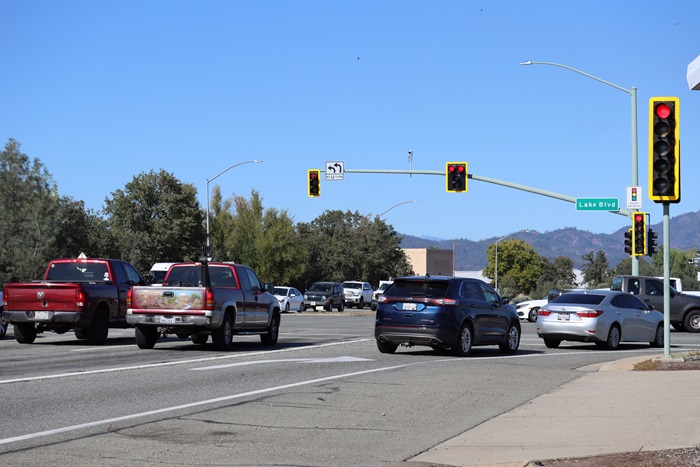CTC greenlights funds that fuel Caltrans’ fine work

District 2 photograph
Mile Marker takes a quick look at what California Transportation Commission has allocated in 2023
As the steward of California’s transportation system, Caltrans constructs, maintains, and manages over 50,000 lane miles of pathways, streets, highways, and freeways, all of which requires money. That’s where the California Transportation Commission (CTC) comes into play.
At six CTC meetings from late January through early December, its 13 members (11 voting, two ex-officio) allocated some $10.8 billion to Caltrans for projects that address highway, passenger rail, transit, and active transportation needs throughout California.
Those allocations included approximately $6.2 billion in funding from the federal Infrastructure Investment and Jobs Act of 2021 (IIJA) and about $1.3 billion in funding from Senate Bill (SB) 1, the Road Repair and Accountability Act of 2017.
The IIJA, also known as the “Bipartisan Infrastructure Law,” is a once-in-a-generation investment in our nation's infrastructure to improve the sustainability and resiliency of our energy, water, broadband, and transportation systems. California has received more than $32 billion since the IIJA’s passage in November 2021, including more than $24 billion in funding for transportation-related projects.
SB 1 provides $5 billion in transportation funding annually that is shared about equally between the state and local agencies. Road projects progress through construction phases more quickly based on the availability of SB 1 funds, including projects that are partially funded by SB 1.
All 12 of Caltrans’ regional districts are beneficiaries of CTC’s allocations. In August, for example, the bigger-ticket projects included:
- $32.8 million in IIJA funding, and $276,000 in SB1 funding for the Lake Boulevard Pavement Project in District 2, in and around Redding. The project’s many improvements include pavement rehabilitation, facility upgrades to meet Americans with Disabilities Act (ADA) standards, and establishment of a Class 1 bike path
- $23.6 million in IIJA funding and $23.6 million in SB 1 funding for the Fort Tejon 2R Rehab Project in District 6, along Interstate 5 in the Grapevine area. The project will rehabilitate pavement and upgrade guardrails, lighting, and Transportation Management System (TMS) elements.
- $40.7 million in IIJA funding for work on Interstate 5 in Encinitas and Carlsbad in District 11. The project includes constructing a southbound auxiliary lane to facilitate merging movements, realigning a ramp at Palomar Airport Road, and adding complete streets enhancements.
In June, the CTC greenlighted $2 billion in IIJA and SB 1 funds while also authorizing an additional $2.3 billion for future projects, including $540 million for active-transportation projects sponsored by local metropolitan planning organizations (MPOs).
The bulk of the future-project allocation covers three SB 1 competitive grant programs: $1.1 billion for the Trade Corridor Enhancement Program (TCEP), $507.4 million for the Solutions for Congested Corridors Program (SCCP), and $142.4 million for the Local Partnership Program (LPP). The evaluation of the programs included, for the first time, input from the new Interagency Equity Advisory Committee. This funding round also marks the first cycle to incorporate all principles of the state’s Climate Action Plan for Transportation Infrastructure.
The TCEP funding will go to 26 projects that support infrastructure improvements on corridors that carry a high volume of freight traffic with the goal of increasing efficiency, improving safety, and constructing an equitable and sustainable freight system. More than a third (10 of 26) of the TCEP projects include zero-emission technology components to support the deployment of a zero-emission freight transportation system and invest in light, medium, and heavy zero-emission vehicle infrastructure.
Three examples of this year’s TCEP allocations are $140 million to fund the Otay Mesa East Port of Entry in San Diego (District 11) at the U.S.-Mexico border, $70 million to fund the Fix 5 (Interstate 5) Cascade Gateway in the city of Redding and Shasta County (District 2), and $41.9 million to fund six Southern California hydrogen fueling facilities.
The SCCP funding will go to 10 projects to achieve a balanced set of transportation, environmental, and community access improvements to reduce congestion throughout the state. All 10 SCCP projects are multimodal, and five include active transportation improvements. The largest of the 10 allocations is $132.4 million to fund the Santa Barbara U.S. Highway 101 Multimodal Corridor Project to increase both non-vehicular and vehicular mobility between Santa Barbara and Ventura counties.
The LPP funding will go to 11 projects that support counties, cities, districts, and regional transportation agencies where voters have approved fees or taxes dedicated solely to transportation. Costliest is $25 million to fund the Oakland Alameda Access Project to improve access between the cities of Oakland and Alameda.
Learn more about this year’s CTC allocations in Caltrans’ news releases from January, March, June and August.
Source: Edward Barrera, senior media officer, Headquarters Public Affairs

